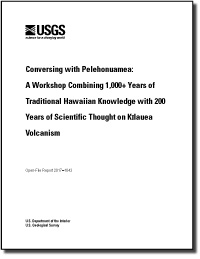Conversing with Pelehonuamea: A workshop combining 1,000+ years of traditional Hawaiian knowledge with 200 years of scientific thought on Kīlauea volcanism
Links
- Document: Report (17.1 MB pdf)
- Version History: Version History (1 KB txt)
- Download citation as: RIS | Dublin Core
Abstract
The events surrounding volcanic eruptions and damaging earthquakes in Hawai‘i have often been described in journals, letters, and newspapers articles in the English language; however, the Hawaiian nation was among the most literate of countries in the 19th century, and many Hawaiian-language newspapers were in circulation through all but the earliest decades of the 19th century. Any modern reconstruction of the history of Hawaiian eruptions or earthquakes should take advantage of all available sources, and so we seek to add the Hawaiian-language newspaper articles, journals, stories, and chants to the volcano and earthquake literature. These sources have been used in many recent volcanological studies.
Another aspect to the mix of science and traditional Hawaiian values is that many of the volcanic summits in Hawaiʻi are considered sacred to Hawaiians. Hawaiian travelers brought the first Western missionary team to the summit of Kīlauea and advised them of the proper protocols and behaviors while in this sacred area. The missionaries dismissed this advice as native superstition and they began a campaign of aggressively stamping out customs and protocols related to the Hawaiian volcano goddess Pelehonuamea. What has survived as native knowledge of the volcanoes is a few phrases from native guides included in some of the missionaries’ journals, and a few stories. Pualani and Kuʻulei Kanahele provide excellent introductions to the Pelehonuamea chants.
In the 21st century, amid a reawakening of Hawaiian culture, modern Hawaiians are demanding protection of their sacred areas, and scientists must be aware of these interests. At the very least, scientists should show respect to Hawaiian values when working in these areas, and should try to minimize disruptions caused by their work. Kaeo Duarte, Peter Mills, and Scott Rowland describe taking this approach in their field work.
Traditional knowledge is also contained in place names. It is important not only to preserve old place names and to recover those no longer used, but also to preserve the stories of those places. Bobby Camara talks about the joys and frustrations of getting information on and recovering Hawaiian place names.
Finally, we hope that a broader interest in Hawaiian views about locations in Hawaiʻi where physical scientific work is done will be as beneficial to physical scientists as it has been to life scientists investigating Hawaiian lifeforms on land and in the ocean, and that both studies will continue to benefit the native peoples of Hawaiʻi.
Note that these proceedings are transcripts of oral presentations illustrated with PowerPoint presentations or charts. Although every effort has been made to assure the accuracy of the oral presentations, there are some gaps where words are not discernible in the voice recordings and are so noted. In other places, bracketed words were added to clarify the speaker’s meaning.
Suggested Citation
Kauahikaua, J.P., and Babb, J.L., comps. and eds., Conversing with Pelehonuamea—A workshop combining 1,000+ years of traditional Hawaiian knowledge with 200 years of scientific thought on Kīlauea volcanism (ver. 1.1, June 2017): U.S. Geological Survey Open File Report 2017–1043, 169 p., https://doi.org/10.3133/ofr20171043.
ISSN: 2331-1258 (online)
Table of Contents
- Preface
- Acknowledgments
- Workshop Schedule
- Pelehonuamea
- Speculative Correlation Between Oral Traditions and Volcanic History of Kīlauea Between ~1200 and 1800 C.E.
- Whose Footprints are They, Really?
- Rising Mist: Ohu Aela I Uka
- Waipiʻo: The Bend in the Water
- GG104—Volcanoes in the Sea: A Course that Examines the Effects of Pacific-Island
- Geology and Geophysics on Pacific Cultures, Past and Present
- Combining Science and Cultural Sensitivity: Nondestructive Sourcing of Polynesian Stone Tools
- Pelehonuamea II
- Traditional Place Names in Hawaiʻi Volcanoes National Park
- Open Discussion of Pelehonuamea with Pua Kanahele
| Publication type | Report |
|---|---|
| Publication Subtype | USGS Numbered Series |
| Title | Conversing with Pelehonuamea: A workshop combining 1,000+ years of traditional Hawaiian knowledge with 200 years of scientific thought on Kīlauea volcanism |
| Series title | Open-File Report |
| Series number | 2017-1043 |
| DOI | 10.3133/ofr20171043 |
| Edition | Version 1.0: Originally posted May 25, 2017; Version 1.1: June 29, 2017 |
| Publication Date | May 25, 2017 |
| Year Published | 2017 |
| Language | English |
| Publisher | U.S. Geological Survey |
| Publisher location | Reston, VA |
| Contributing office(s) | Volcano Science Center |
| Description | Report: version 1.1, 169 p. |
| Country | United States |
| State | Hawaii |
| Other Geospatial | Kīlauea |
| Online Only (Y/N) | Y |


